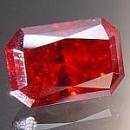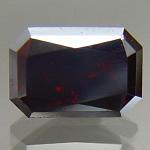|
|
||||||||||||||||
|
||||||||||||||||
|
||||||
|
|
|
|
Cuprite
|
|
| | |
| Possibly discovered as early as 1546; IMA status: Valid (pre-IMA; Grandfathered) | ||
|
| ||
|
Chemistry |
|
|
| |
|
Cu2O | |
|
|
Copper Oxide |
|
Molecular Weight: |
143.09 gm |
|
Composition: |
Copper |
88.82 % |
Cu |
100.00 % |
Cu2O |
|
|
Oxygen |
11.18 % |
O |
|
|
|
|
|
100.00 % |
|
100.00 % |
= TOTAL OXIDE |
|
|
|
||||
|
Classification |
|
|
| |
|
Oxides | |
|
4/A.02-10 | |
|
|
4 : OXIDES (Hydroxides, V[5,6] vanadates, arsenites, antimonites, bismuthites, sulfites, selenites, tellurites, iodates)
|
|
Related to: |
n/a |
|
Varieties: |
Chalcotrichite, Tile ore |
|
Synonyms: |
ICSD 63281, Hepatinerz (of Breithaupt), Kupferglas, Octahedral Copper, Octahedral Copper Ore, Oxydulated Copper, PDF 5-667, Red Copper, Red Glassy Copper Ore, Red oxide of Copper, Ruberite, Ruby Copper |
|
|
|
|
Crystal Data |
|
|
|
|
|
As cubic, octahedral, and dodecahedral crystals, to 14 cm, which may be highly modified; as hairlike capillary forms, with square section, reticulated, tufted and matted; also earthy, compact granular, massive. |
|
|
Penetration twins common |
|
|
|
|
|
Physical Properties |
|
|
|
|
|
Interrupted on {111}, more rarely on {001} |
|
|
Conchoidal, irregular/uneven |
|
|
Brittle |
|
|
3.5 - 4.0; Vickers: VHN100=183 - 222 kg/mm2 |
|
|
6.14 g/cm3 (measured) |
|
|
None |
|
|
Not Radioactive |
|
|
|
|
|
Optical Properties |
|
|
|
|
|
Cochineal-red, ruby-red, purplish red, to nearly black; in transmitted light, cochineal-red or red in thick sections; yellow-orange, yellow, lemon-yellow in progressively thinner sections; in reflected light, gray blue, commonly with many red internal reflections |
|
|
Transparent to translucent |
|
|
Adamantine to submetallic, earthy |
|
|
2.849 Isotropic |
|
|
0.000 (Isotropic) |
|
|
n/a |
|
|
Anomalous, common |
|
|
Anomalously anisotropic. Color in reflected light: bluish white. Internal reflections: blood-red. |
|
|
|
|
|
Occurances |
|
|
|
|
|
Geological Setting: |
A common mineral in the oxidized portions of many copper deposits. |
|
Common Associations: |
Copper, Tenorite, Malachite, Azurite, Calcite, Brochantite, Antlerite, Atacamite, Chrysocolla, iron oxides, clay minerals |
|
Common Impurities: |
n/a |
|
Type Locality: |
Unknown |
|
Year Discovered: |
Possibly discovered as early as 1546. |
|
View mineral photos: | |
|
|
|
|
More Information |
|
|
|
|
|
| |
|
|
|
|
Cuprite is commonly found as an oxidation product of copper sulphides in the upper zones of veins and often associated with Azurite, Chalcocite, Native Copper, Limonite and Malachite. A fibrous form of Cuprite is known as Chalcotrichite. Cuprite crystals and gems may be so dark red as to look almost black but when properly lit can show a truely amazing ruby or blood red color. Cuprite was named in 1845 by Wilhelm Karl von Haidinger from the Latin word cuprum, meaning copper, in allusion to its composition. Haidinger renamed a previously known mineral that had been known by a wide variety of names. The earliest reference to Cuprite may have been in 1546 by the German name Lebererzkupfer, meaning liver ore copper. Other previous names were: Hepatinerz (of Breithaupt), Kupferglas, Ruberite, Ruby Copper and Ziegelerz. Cuprite
distribution: A few localities for fine specimens include:
at Bogoslovsk, Nizhni Tagil, and Yekaterinburg (Sverdlovsk),
Ural Mountains, Russia. At Dzhezkazgan, Kazakhstan.
In England, fine crystals from many mines in Cornwall.
At Rheinbreitbach, North Rhine-Westphalia, Germany.
In Namibia, large crystals from the Onganja mine, 60
km northeast of Windhoek, and at Tsumeb. At Likasi,
Ruwe, and the Mashamba West mine, Kolwezi, Katanga Province,
Congo (Shaba Province, Zaire). In the USA, in Arizona,
large crystals from Bisbee, Cochise County, at Ray,
Pinal County, Globe, Gila County, and elsewhere; from
Santa Rita, Grant County, New Mexico. From Boleo, Baja
California, Mexico. At Chuquicamata, Antofagasta, Chile.
In Australia, from Broken Hill and Cobar, New South
Wales; at Burra-Burra and Moonta, South Australia; large
crystals in the Red Dome mine, Chilliago, Queensland.
|
|
|
|||||||||||||||||||||||||||


